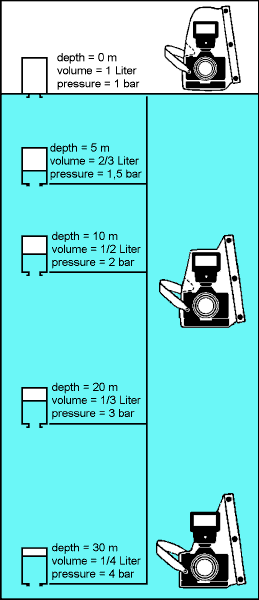Flexible housings: What's that ?
How it really works
The biggest safety feature of a flexible ewa-marine housing is the fact that the air pressure inside the housing is always the same as the water pressure outside. As a result, there is no undue stress on any seal and no risk of implosion. We are also able to use a thinner front port then comparable hard housings, thus reducing the otherwise resulting quality losses in the pictures.
The relationship between volume and pressure is described by the law of physics according to Boyle-Mariotte:
pressure x volume = constant
We have designed the housings with this in mind and have left enough air around the camera in an inflated housing for you to reach the depth we tested ourselves. The foam padding and valves supplied with selected housings help to ensure that the maximum amount of air can be included in the housing while allowing access to all the relevant controlls.
Nevertheless, the volume is also the factor that determines the buoyancy. For that reason it might be preferable to reduce the amount of air in the housing for snorkeling. Also please keep in mind, that the housing will be very buoyant at the surface, but as you descend and the volume decreases, it will even develop a negative buoyancy (start to sink) with some heavier cameras or camcorders.
When you have reach the tested depth, all the air will have been pressed inside the camera or camcorder itself. If you continue your descent, the pressure sensitive parts will be affected first and at a very small pressure difference (shutter release, power, etc.), thus causing a malfunction of your camera or camcorder. Stop the descent immediately, return to a safe depth, and all will return to normal.
PLEASE NOTE:
There is a groove at the rear of the closing rail. As you submerge the housing bubbles will escape from this grove. This should last for about 1/2 Minute and before coming to an end. This phenomena is normal and has nothing to do with whether the housing is waterproof or not.
